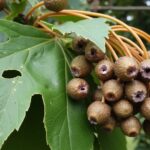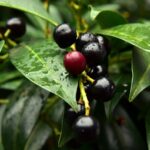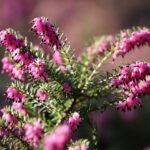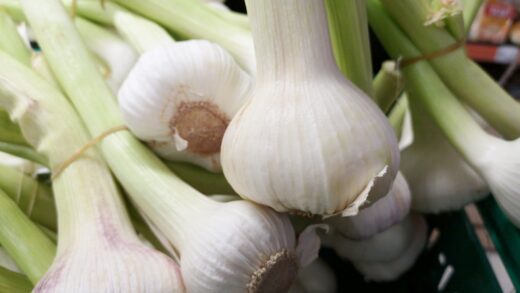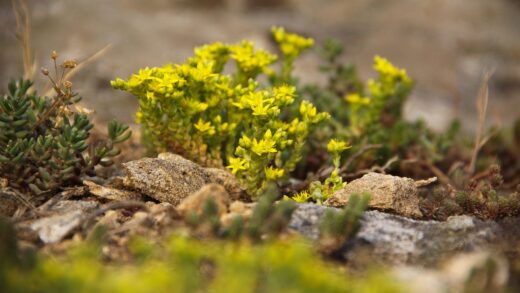Maintaining the health of a lemon tree involves a vigilant and proactive approach to managing the various diseases and pests that can afflict it. These issues can range from minor cosmetic damage to severe infestations or infections that threaten the life of the tree. A successful management strategy relies on regular inspection to detect problems early, correct identification of the specific pest or pathogen, and the implementation of appropriate control measures. By integrating good cultural practices that promote a strong and resilient tree, the likelihood and severity of these problems can be significantly reduced, ensuring the plant remains vigorous and productive.
Pests that commonly target lemon trees are often sap-sucking insects that feed on the plant’s vital fluids. These include aphids, scale insects, spider mites, and mealybugs, which can cause a range of symptoms from distorted growth and yellowing leaves to the formation of a sticky residue known as honeydew. This honeydew, in turn, can lead to a secondary problem: the growth of black, unsightly sooty mold on the surfaces of leaves and stems. While sooty mold itself does not directly harm the plant, it can block sunlight and reduce photosynthesis, weakening the tree over time.
Fungal diseases are another significant concern, particularly those that thrive in conditions of high humidity, poor air circulation, and excessive moisture. Root rot, caused by the Phytophthora fungus, is one of the most serious and is almost always linked to overwatering and poorly draining soil. Other common fungal issues include greasy spot, which causes oily-looking blisters on leaves, and anthracnose, which can cause leaf drop and fruit rot. Preventing these diseases is primarily a matter of controlling the environmental conditions through proper watering and pruning.
Effective management begins with prevention. A healthy, well-cared-for tree is inherently more resistant to pests and diseases than a stressed one. This means providing optimal conditions, including adequate sunlight, proper irrigation, and a balanced nutrient supply. Regular monitoring is the next line of defense, allowing for the early detection of any issues before they become widespread. When control measures are necessary, it is often best to start with the least toxic methods, such as physical removal of pests or the use of horticultural oils and soaps, before resorting to stronger chemical treatments.
Common sap-sucking pests
Aphids are small, soft-bodied insects that often cluster on the tender new growth of lemon trees, such as young leaves and flower buds. They use their piercing mouthparts to suck the sap from the plant, which can cause the new growth to become stunted, curled, or distorted. Aphids reproduce very quickly, and a small population can rapidly grow into a major infestation. As they feed, they excrete honeydew, which attracts ants and promotes the growth of sooty mold, adding another layer of problems for the tree.
Scale insects are another common pest that can be more difficult to detect. These insects have a hard, waxy, shell-like covering that protects them from predators and many pesticides, making them challenging to control. They attach themselves firmly to stems, leaves, and even the fruit of the lemon tree, where they remain stationary and feed on the plant’s sap. A heavy infestation can cause yellowing of leaves, dieback of small branches, and a general decline in the tree’s vigor.
Spider mites, which are technically arachnids rather than insects, are tiny pests that are difficult to see with the naked eye. Their presence is often first indicated by the appearance of fine webbing on the undersides of leaves and between branches. They thrive in hot, dry conditions and feed by piercing plant cells to suck out their contents. This feeding activity creates a stippling pattern of tiny yellow or white dots on the leaves, and in severe cases, the leaves can turn yellow or bronze and drop from the tree.
Mealybugs are small, oval-shaped insects covered in a white, waxy, cotton-like substance that protects them. They tend to congregate in protected areas of the plant, such as in leaf axils and other crevices. Like other sap-sucking pests, they feed on the plant’s juices, leading to stunted growth and leaf drop, and they also produce copious amounts of honeydew. Controlling these pests often requires a persistent approach, as their waxy coating and tendency to hide make them resistant to simple sprays.
Fungal and bacterial diseases
Root rot is arguably the most dangerous disease for a lemon tree, especially those grown in containers. This disease is caused by soil-borne fungi, most commonly from the Phytophthora genus, which thrive in waterlogged, anaerobic conditions. The fungus attacks the tree’s root system, causing the roots to become dark, mushy, and decayed. As the root system is destroyed, it can no longer absorb water and nutrients, leading to symptoms in the canopy that include wilting, yellowing leaves, and eventual tree death. Prevention through proper watering and the use of well-draining soil is the only effective cure.
Greasy spot is a fungal disease that affects the foliage of citrus trees, causing characteristic symptoms on the leaves. The infection typically begins on the underside of the leaf, eventually producing yellow-brown blisters on both sides. These spots later darken and become slightly raised, with a greasy appearance, hence the name. Severe infections can lead to significant defoliation, which weakens the tree and can reduce fruit production. This disease is favored by high humidity and long periods of leaf wetness, so improving air circulation through pruning can help in its prevention.
Sooty mold is a common sight on lemon trees that are infested with sap-sucking insects like aphids, scale, or mealybugs. The mold itself is a fungus that does not infect the plant but rather grows on the surface of the sugary honeydew excreted by these pests. It forms a black, powdery coating on leaves, stems, and fruit. While it does not directly feed on the tree, a thick layer of sooty mold can block sunlight, interfering with photosynthesis and reducing the overall vigor of the plant. The key to controlling sooty mold is to eliminate the pest infestation that is producing the honeydew.
Citrus canker is a serious bacterial disease that can affect all parts of the lemon tree, including leaves, stems, and fruit. It is caused by the bacterium Xanthomonas citri and results in the formation of raised, corky lesions or scabs. These lesions are often surrounded by a yellow halo on the leaves and can cause premature leaf and fruit drop, as well as unsightly blemishes on the lemons. The disease is highly contagious and is spread by wind and rain. In many commercial citrus-growing regions, there are strict regulations in place to control its spread, and infected trees may need to be removed and destroyed.
Integrated pest management strategies
Integrated Pest Management (IPM) is a holistic and environmentally sensitive approach to controlling pests and diseases. The foundation of IPM is prevention through good cultural practices. This involves creating an environment where the lemon tree is as healthy and resilient as possible. A strong tree is better able to withstand and recover from pest attacks and diseases. Key cultural practices include selecting a sunny and well-ventilated location, using well-draining soil, watering correctly to avoid stress, and providing balanced nutrition through proper fertilization.
Regular monitoring is a cornerstone of any IPM program. This means closely inspecting the lemon tree on a frequent basis, at least once a week, to look for the early signs of any problems. Check the tops and undersides of leaves, the stems, and the junctions where leaves meet the stem. Catching a pest infestation when it consists of only a few individuals or a disease at its very first appearance is much easier to manage than dealing with a widespread problem. Early detection allows for the use of simpler and less toxic control methods.
When a pest problem is identified, IPM prioritizes the use of mechanical and biological controls before resorting to chemical pesticides. Mechanical controls can be as simple as hand-picking larger pests like caterpillars or using a strong spray of water from a hose to dislodge aphids and spider mites. Biological control involves using a pest’s natural enemies to keep its population in check. This can mean encouraging beneficial insects like ladybugs, lacewings, and predatory wasps in the garden, which prey on common pests like aphids and scale.
If chemical intervention becomes necessary, an IPM approach favors the use of the least toxic options first. Products like insecticidal soaps and horticultural oils are effective against many soft-bodied insects and have a low impact on beneficial insects and the environment. These are considered contact pesticides, so they must be sprayed directly onto the pests to be effective. Stronger, broad-spectrum chemical pesticides should only be used as a last resort, as they can kill beneficial insects, disrupt the local ecosystem, and lead to the development of pesticide-resistant pest populations.
Treatment and control methods
For minor infestations of sap-sucking insects like aphids and mealybugs, simple physical methods are often sufficient. A strong jet of water can be used to blast them off the plant. For more stubborn pests like mealybugs or small clusters of scale, a cotton swab or a soft brush dipped in isopropyl (rubbing) alcohol can be used to wipe them away directly. This method is precise and avoids the use of any pesticides, making it ideal for small-scale infestations on houseplant lemon trees.
Horticultural oils, including neem oil, and insecticidal soaps are excellent low-toxicity options for controlling a wide range of pests. These products work by suffocating the insects or disrupting their outer cell membranes. They are most effective against soft-bodied pests like aphids, spider mites, mealybugs, and the crawler stage of scale insects. It is crucial to apply these sprays thoroughly, ensuring complete coverage of all plant surfaces, especially the undersides of leaves where pests often congregate. Repeat applications are usually necessary to control newly hatched pests.
When dealing with fungal diseases, prevention and environmental control are the most effective tools. Improving air circulation by selectively pruning branches from the center of the tree can help leaves dry more quickly, creating a less favorable environment for fungal spores to germinate. For existing fungal infections like greasy spot or powdery mildew, fungicides may be required. Copper-based or sulfur-based fungicides are traditional and often effective treatments, but they should always be used strictly according to the manufacturer’s label to ensure safety and efficacy.
For the most serious issues, such as a severe scale infestation or a persistent fungal disease, a more systemic approach may be warranted, although this should be a last resort. Systemic pesticides are absorbed by the plant and move through its vascular tissues, making the entire plant toxic to feeding insects. While effective, these can also be harmful to beneficial insects and pollinators that may visit the tree’s flowers. Therefore, their use should be carefully considered, and they should be applied at times when pollinators are not active.
Preventing future outbreaks
The most effective long-term strategy for managing pests and diseases is to focus on preventing them from occurring in the first place. This begins with providing the lemon tree with its ideal growing conditions to minimize stress. A tree that is stressed by insufficient light, improper watering, or poor nutrition is significantly more susceptible to attack. Ensuring the tree receives at least six to eight hours of direct sun, is planted in well-draining soil, and is watered and fertilized appropriately builds its natural defenses.
Good sanitation practices play a crucial role in preventing the spread of diseases. This involves keeping the area around the tree clean and free of fallen leaves, fruit, and other debris. This organic matter can harbor fungal spores and provide a hiding place for overwintering pests. Any pruned branches or leaves that show signs of disease should be removed from the area and disposed of, rather than being added to a compost pile where the pathogens could potentially survive and spread.
Pruning is not only important for shaping the tree and encouraging fruit production but also for disease prevention. Selectively thinning out branches from the canopy, especially in the center of the tree, improves air circulation. Good airflow helps the leaves to dry off more quickly after rain or watering, which significantly reduces the likelihood of fungal diseases that require moist conditions to thrive. A more open canopy also allows for better penetration of sunlight, which can further inhibit fungal growth.
Finally, when introducing any new plants into your home or garden, it is wise to quarantine them for a few weeks before placing them near your existing plants. This isolation period allows you to observe the new plant for any signs of hidden pests or diseases that may have been present when you acquired it. This simple preventative measure can stop a potential infestation or infection from spreading to your healthy lemon tree and other plants, saving you a great deal of trouble in the long run.
📷 Pixabay

